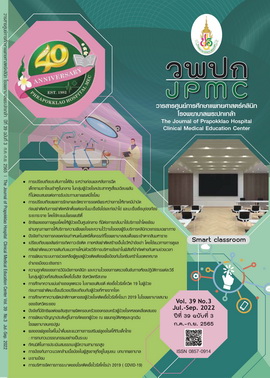การเปรียบเทียบผลการรักษาและอัตราการรอดชีพระหว่างการให้ยาเคมีบำบัดก่อนผ่าตัดกับการผ่าตัดหลักตั้งแต่แรกในมะเร็งรังไข่และท่อนำไข่ และมะเร็งเยื่อบุช่องท้องระยะกระจายโดยใช้คะแนนโพรเพนซิตี้
Main Article Content
บทคัดย่อ
ที่มาของปัญหา: มะเร็งรังไข่พบมากเป็นอันดับ 2 รองจากมะเร็งเต้านม แต่เป็นสาเหตุของการเสียชีวิตอันดับ 1 ในมะเร็งนรีเวช และเป็นระยะกระจายเพราะมาพบแพทย์ช้า ทำให้เป็นซ้ำสูง
วัตถุประสงค์: เพื่อศึกษาผลการรักษาและการรอดชีพเปรียบเทียบระหว่างการให้ยาเคมีบำบัดก่อนผ่าตัด (neoadjuvant chemotherapy; NACT) กับการผ่าตัดหลักตั้งแต่แรก (primary surgery) ในผู้ป่วยมะเร็งรังไข่ ท่อนำไข่ และ เยื่อบุช่องท้อง ระยะกระจาย
วิธีการศึกษา: เป็นการศึกษาแบบ Therapeutic research รูปแบบ Retrospective cohort design ที่กลุ่มงานสูตินรีเวชกรรม โรงพยาบาลสุรินทร์ ใน ผู้ป่วยมะเร็งรังไข่ ท่อนำไข่ และ เยื่อบุช่องท้อง ระยะ 3-4 ระหว่างวันที่ 1 มกราคม พ.ศ. 2554 ถึงวันที่ 31 ธันวาคม พ.ศ. 2563 และสามารถติดตามการรักษาถึงวันที่ 30 พฤศจิกายน พ.ศ. 2564 รวบรวมข้อมูลผู้ป่วยและแบ่ง 2 กลุ่มคือ กลุ่ม NACT และกลุ่ม primary surgery บันทึกข้อมูลพื้นฐาน ระยะของโรค ECOG ระดับค่ามะเร็ง CA125 แรกวินิจฉัย ชนิดเซลล์มะเร็ง ระดับความรุนแรงของเซลล์มะเร็ง น้ำในช่องท้อง ชนิดยาเคมีบำบัด แล้วมาประเมินผลการรักษาโดยใช้ Multivariable binary risk regression และ Propensity score analysis แบบ Covariable modeling
ผลการศึกษา: ผู้ป่วย 220 ราย เป็นกลุ่ม NACT 87 ราย และ primary surgery 133 ราย พบว่า กลุ่ม NACT มีอายุเฉลี่ย 56.8 ปี มากกว่ากลุ่ม primary surgery (52.7 ปี) ค่าคะแนนเฉลี่ย propensity score ของกลุ่ม NACT คือ 0.6±0.3 เป็น 2 เท่าของกลุ่ม primary surgery (0.3±0.2) กลุ่ม NACT มี complete remission น้อยกว่ากลุ่ม primary surgery (ร้อยละ 37.9 vs 68.4) แต่มี partial หรือ stable และ dead สูงกว่า แต่หลังจากปรับด้วย propensity score แล้วพบว่าไม่แตกต่างกัน แต่ NACT มีแนวโน้มที่จะ remission สูงกว่า และการเสียชีวิตไม่ต่างกันทางสถิติ
สรุป: การรักษามะเร็งรังไข่ มะเร็งท่อนำไข่ และมะเร็งเยื่อบุช่องท้อง ระยะกระจายสามารถทำได้ทั้ง NACT หรือ primary surgery เนื่องจากหลังจากที่ปรับด้วย propensity score แล้ว complete remission, partial or stable และ dead ไม่แตกต่างกันทางสถิติ
Thaiclinicaltrials.org number, TCTR20220225007
Article Details

This work is licensed under a Creative Commons Attribution-NonCommercial-NoDerivatives 4.0 International License.
References
Ferlay J, Soerjomataram I, Dikshit R, Eser S, Mathers C, Rebelo M, et al. Cancer incidence and mortality worldwide: sources, methods and major patterns in GLOBOCAN 2012. Int J Cancer [Internet]. 2015[cited 2021 Jan 2];136(5):E359-86. Available from: https://onlinelibrary.wiley.com/doi/10.1002/ijc.29210
Jittithaworn S.. Ovarian cancer [internet].2020 [cited 2021 Sep 15]. Available from: https://www.rama.mahidol.ac.th/cancer_center/th/knowledge/gyne/ovary
Griffiths CT. Surgical resection of tumor bulk in the primary treatment ofovarian carcinoma.Natl Cancer InstMonogr 1975;42:101-4.
Bristow RE, Tomacruz RS, Armstrong DK, Trimble EL, Montz FJ. Survival effect of maximal cytoreductive surgery for advanced ovarian carcinoma during the platinum era: a meta-analysis. J Clin Oncol 2002;20:1248-59.
Kehoe S, Hook J, Nankivell M, Jayson GC, Kitchener H, Lopes T, et al. Primary chemotherapy versus primary surgeryfor newly diagnosed advanced ovarian cancer (CHORUS): an open-label, randomised,controlled, non-inferiority trial. Lancet 2015;386(9990):249-57.
Vergote I, Tropé CG, Amant F, Kristensen GB, Ehlen T, Johnson N, et al. Neoadjuvant chemotherapy or primary surgery in stage IIIC or IV ovarian cancer. New England Journal of Medicine 2010;363:943-53.
Fagotti A, Vizzielli G, Fanfani F, Chiantera V, Margariti PA, Gallotta V, et al. Phase III SCORPION trial (ID number: NCT01461850) in epithelial ovarian cancer patients with high tumor load receiving PDS versus NACT: An interim analysis on peri-operative outcome. Gynecologic Oncology 2015;138(S1):1-4.
Onda T, Satoh T, Saito T, Kasamatsu T, Nakanishi T, Nakamura K, et al. Comparison of treatment invasiveness between upfrontdebulking surgery versus interval debulking surgery following neoadjuvantchemotherapy for stage III/IV ovarian, tubal, and peritoneal cancers in a phaseIIIrandomised trial: Japan Clinical Oncology Group Study JCOG0602. EurJCancer. 2016;64:22-31.
Reuss A, du Bois A, Harter P, Fotopoulou C, Sehouli J, Aletti G, et al. TRUST: Trial of radical upfront surgical therapy in advanced ovariancancer (ENGOT ov33/AGO-OVAR OP7). Int J Gynecol Cancer2019;29:1327-31.
Vergote I, Coens C, Nankivell M, Kristensen GB, Parmar MKB, Ehlen T, et al. Neoadjuvant chemotherapy versus debulking surgery in advancedtubo-ovarian cancers: pooled analysis of individual patient data from the EORTC55971 and CHORUS trials. Lancet Oncol 2018;19:1680-7.
Coleridge SL, Bryant A, Lyons TJ, Goodall RJ, Kehoe S, Morrison J. Chemotherapy versus surgery for initial treatment in advanced ovarian epithelial cancer. Cochrane Database Syst Rev [ internet] 2019 [cited 2021 Sep 11]. Available from: https://www.ncbi.nlm.nih.gov/pmc/articles/PMC6822157/pdf/CD005343.pdf
Thrall MM, Gray HJ, Symons RG, Weiss NS, Flum DR, Goff BA. Neoadjuvant chemotherapy in the Medicare cohort with advanced ovarian cancer. GynecolOncol 2011;123:461-6.
Wright AA, Bohlke K, Armstrong DK, Bookman MA, Cliby WA, Coleman RL, et al. Neoadjuvant chemotherapy for newly diagnosed,advanced ovarian cancer: Society of Gynecologic Oncology and American Society ofClinical Oncology Clinical Practice Guideline. GynecolOncol 2016;143:3-15.
vanMeurs HS, Tajik P, Hof MHP, Vergote I, Kenter GG, Mol BW, et al. Which patients benefit most from primary surgery or neoadjuvantchemotherapy in stage IIIC or IV ovarian cancer? An exploratory analysis of theEuropeanOrganisation for Research and Treatment of Cancer 55971 randomisedtrial. Eur J Cancer 2013;49:3191-201.
Russell B, Hawarden A, Gee M, Edmondson RJ. Propensity score matchingconfirms that primary surgery or neoadjuvant chemotherapy result in equivalentsurvival within a comprehensive cohort of patients with high-grade serousovarian cancer. GynecolOncol2021;160(1):24-31.
